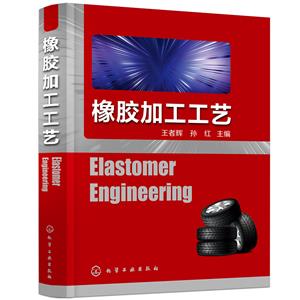-
>
湖南省志(1978-2002)?铁路志
-
>
公路车宝典(ZINN的公路车维修与保养秘籍)
-
>
晶体管电路设计(下)
-
>
基于个性化设计策略的智能交通系统关键技术
-
>
德国克虏伯与晚清火:贸易与仿制模式下的技术转移
-
>
花样百出:贵州少数民族图案填色
-
>
识木:全球220种木材图鉴
橡胶加工工艺(Elastomer Engineering) 版权信息
- ISBN:9787122383655
- 条形码:9787122383655 ; 978-7-122-38365-5
- 装帧:一般胶版纸
- 册数:暂无
- 重量:暂无
- 所属分类:>>
橡胶加工工艺(Elastomer Engineering) 本书特色
本书主要介绍橡胶生产中常使用的各种配合剂,概述了橡胶配方设计基础知识;重点介绍橡胶的塑炼、混炼、压延、、压出、硫化各个环节的原理、工艺条件和工艺过程以及影响因素,常见的质量问题及解决办法等。
橡胶加工工艺(Elastomer Engineering) 内容简介
《橡胶加工工艺(Elastomer Engineering)》主要内容包括:第1章“高分子化学:橡胶合成(Polymer Chemistry : Elastomer Synthesis)”;第2章“橡胶高弹性:基本原理与性质(Polymer Elasticity: Basic Concepts and Behavior)”;第3章“橡胶配合(Rubber Compounding)”;第4章“橡胶补强剂(Reinforcement of Elastomers by Particulate Fillers)”;第5章“橡胶硫化(Vulcanization)”;第6章“生胶加工工艺(Processing of Unvulcanized Elastomer)”;第7章“橡胶加工流变性(Rheological Behavior in Elastomer Processing)”;第8章“热塑性弹性体(Thermoplastic Elastomers)”;第9章“橡胶共混(Elastomer Blends)”;第10章“橡胶化学改性(Chemical Modification of Elastomers)”;第11章“橡胶强度(Strength of Elastomers)”;第12章“轮胎工艺(Tire Engineering)”;第13章“橡胶再生(Elastomer Recycling)”。本书内容全面,不仅综述性强,而且前沿性强,将橡胶加工新技术与新工艺呈现给读者。 《橡胶加工工艺(Elastomer Engineering)》可供高等学校橡胶工程技术、高分子材料工程技术专业,以及与高分子材料、橡胶工程专业相关的高分子材料与工程、复合材料、材料工程应用技术等本科专业作为教材,也可供橡胶企业工程技术人员和各类橡胶技术培训班学员等参考使用。
橡胶加工工艺(Elastomer Engineering) 目录
1.1Introduction2
1.2Classification of Polymerization Reactions and Kinetic Considerations3
1.3Polyaddition/ Polycondensation6
1.4Chain Polymerization by Free Radical Mechanism8
1.5Emulsion Polymerization14
1.6Copolymerization23
1.7Chain Polymerization by Cationic Mechanism28
1.8Chain Polymerization by Anionic Mechanism34
1.9Stereospecific Chain Polymerization and Copolymerization by Coordination Catalysts43
1.10Graft and Block Copolymerization51
References57
Chapter 2Polymer Elasticity: Basic Concepts and Behavior65
2.1Introduction66
2.2Elasticity of a Single Molecule66
2.3Elasticity of a Three-Dimensional Network of Polymer Molecules69
2.4Comparison with Experiment72
2.5Continuum Theory of Rubber Elasticity74
2.6Second-Order Stresses80
2.7Elastic Behavior Under Small Deformations81
2.8Some Unsolved Problems in Rubber Elasticity84
References85
Chapter 3Rubber Compounding87
3.1Introduction87
3.2Polymers87
3.3Filler Systems98
3.4Stabilizer Systems108
3.5Vulcanization System113
3.6Special Compounding Ingredients120
3.7Compound Development123
3.8Compound Preparation126
3.9Environmental Requirements in Compounding126
3.10Summary129
References129
Chapter 4Reinforcement of Elastomers by Particulate Fillers131
4.1Introduction131
4.2Preparation of Fillers131
4.3Morphological and Physicochemical Characterization of Fillers134
4.4The Mix:a Nanocomposite of Elastomer and Filler143
4.5Mechanical Properties of Filled Rubbers148
References157
Chapter 5Vulcanization158
5.1Introduction158
5.2Definition of Vulcanization158
5.3Effects of Vulcanization on Vulcanizate Properties159
5.4Characterization of the Vulcanization Process161
5.5Vulcanization by Sulfur without Accelerator164
5.6Accelerated-Sulfur Vulcanization165
References194
Chapter 6Processing of Unvulcanized Elastomer195
6.1Introduction195
6.2Two Roll Mill195
6.3Internal Mixers197
6.4Continuous Mixers201
6.5Trouble Shooting the Mixing Process202
6.6Extrusion Process203
6.7Calendering206
6.8Continuous Vulcanization System211
6.9Moulding212
References217
Chapter 7Rheological Behavior in Elastomer Processing219
7.1Introduction219
7.2Basic Concepts of Mechanics223
7.3Rheological Properties225
7.4Boundary Conditions241
7.5Mechanochemical Behavior244
7.6Rheological Measurements246
7.7Processing Technology251
7.8Engineering Analysis of Processing261
References270
Chapter 8Thermoplastic Elastomers281
8.1Introduction281
8.2Synthesis of Thermoplastic Elastomers286
8.3Morphology of Thermoplastic Elastomers292
8.4Properties and Effect of Structure309
8.5Thermodynamics of Phase Separation315
8.6Thermoplastic Elastomers at Surfaces320
8.7Rheology and Processing326
8.8Applications329
References330
Chapter 9Elastomer Blends331
9.1Introduction331
9.2Miscible Elastomer Blends333
9.3Immiscible Elastomer Blends338
9.4Conclusion350
References350
Chapter 10Chemical Modification of Elastomers355
10.1Introduction355
10.2Chemical Modification of Polymers within Backbone and Chain Ends356
10.3Esterification,Etherification,and Hydrolysis of Polymers357
10.4The Hydrogenation of Polymers360
10.5Dehalogenation,Elimination,and Halogenation Reactions in Polymers361
10.6Other Addition Reactions to Double Bonds364
10.7Oxidation Reactions of Polymers366
10.8Functionalization of Polymers367
10.9Miscellaneous Chemical Reactions of Polymers367
10.10Block and Graft Copolymerization368
References380
Chapter 11Strength of Elastomers382
11.1Introduction382
11.2Initiation of Fracture383
11.3Threshold Strengths and Extensibilities388
11.4Fracture Under Multiaxial Stresses390
11.5Crack Propagation394
11.6Tensile Rupture401
11.7Repeated Stressing:Mechanical Fatigue406
11.8Surface Cracking by Ozone408
11.9Abrasive Wear409
References412
Chapter 12Tire Engineering415
12.1Introduction416
12.2Tire Types and Performance417
12.3Basic Tire Design419
12.4Tire Engineering421
12.5Tire Materials431
12.6Tire Testing444
12.7Tire Manufacturing448
12.8Summary452
References454
Chapter 13Elastomer Recycling456
13.1Introduction456
13.2Retreading of Tire458
13.3Recycling of Rubber Vulcanizates459
13.4Use of Recycled Rubber474
13.5Pyrolysis and Incineration of Rubber484
13.6Concluding Remarks485
References485
Appendix ⅠDemonstration492
Appendix ⅡAcronyms for Common Elastomers498
- >
山海经
山海经
¥19.7¥68.0 - >
回忆爱玛侬
回忆爱玛侬
¥23.0¥32.8 - >
小考拉的故事-套装共3册
小考拉的故事-套装共3册
¥36.7¥68.0 - >
上帝之肋:男人的真实旅程
上帝之肋:男人的真实旅程
¥19.3¥35.0 - >
伊索寓言-世界文学名著典藏-全译本
伊索寓言-世界文学名著典藏-全译本
¥9.3¥19.0 - >
随园食单
随园食单
¥15.4¥48.0 - >
【精装绘本】画给孩子的中国神话
【精装绘本】画给孩子的中国神话
¥19.3¥55.0 - >
史学评论
史学评论
¥22.7¥42.0
-
聚酰亚胺泡沫材料-(第2版)
¥56¥128 -
磷腈阻燃材料(精)
¥118.5¥158 -
陶瓷坯釉料制备技术
¥57.2¥78 -
聚酰亚胺纤维
¥41.8¥68 -
化工辞典-第五版
¥103.5¥138 -
4.23文创礼盒A款--“作家言我精神状态”
¥42.3¥206





















